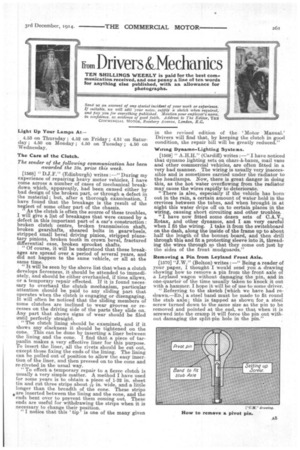fro. Drivers &Mechanics
Page 19

If you've noticed an error in this article please click here to report it so we can fix it.
Light Up Your Lamps At
4.53 on Thursday ; 4.52 on Friday ; 4.51 on Saturday; 4.50 on Monday ; 4.50 on Tuesday ; 4.50 on Wednesday.
The Care of the Clutch.
The sender of the following communication has been awarded the .r0s. prize this week.
[1568] " D.J.F." (Edinburgh) writes : —" During my experience of repairing heavy motor vehicles, I have come across a number of cases of mechanical breakdown which, apparently, had been caused either by bad design of the broken part, or through a defect in the material; but, after a thorough examination, I have found that the breakage is the result of the neglect of some other part of the chassis. 'As the clutch is often the source of these troubles, I will give a list of breakages that were caused by a defect in this important part of a car's construction : broken clutch centre, broken transmission shaft, broken gearshafts, sheared bolts in gearwheels, stripped small bevel driving pinion, stripped planetary pinions, broken tooth in crown bevel, fractured differential case, broken sprocket shafts. "Of course, it will be understood that these breakages are spread over a period of several years, and did not happen to the same vehicle, or all at the same time.
"It will be seen by the above list that when a clutch develops fierceness, it should be attended to immediately, and should be either overhauled, if time allows, or a temporary repair effected. If it is found necessary to overhaul, the clutch mechanism, particular attention should be paid to any sliding part that operates when the clutch is engaging or disengaging. it will often be noticed that the sliding members of some clutches are inclined to wear grooves or recesses on the driving side of the parts they elide on. Any part that shows signs of wear should be filed until perfectly straight.
"The clutch lining should be examined, and if it shows any slackness it should be tightened on the cone. This can be done by inserting a liner between the lining and the cone. I find that a piece of tarpaulin makes a very effective liner for this purpose. 'Po insert the liner, all the rivets should be cut out, except those fixing the ends of the lining. The lining can be pulled out of position to allow the easy insertion of the liner, and then pressed on to the cone and re-riveted in the usual way.
"To effect a temporary repair to a fierce clutch is usually a very simple matter. A. method I have used for some years is to obtain a piece of 1-32 in. sheet tin and cut three strips about ti in. wide, and a little longer than the breadth of the cone. These strips sere inserted between the lining and the cone, and the ends bent over to prevent them coming out. These ends are useful for withdrawing the strips when it is necessary to change their position.
"I notice that this ' tip ' is one of the many given in the revised edition of the 'Motor Manual.' Drivers will find that, by keeping the clutch in good condition, the repair bill will be greatly reduced."
Wiring Dynamo-Lighting Systems.
[1569] " A.H.H." (Cardiff) writes :—"i have noticed that dynamo lighting sets on chars-à-banes, mail vans and other commercial vehicles, are often fitted in a very bad manner. The wiring is usually very inaccessible and is sometimes carried under the radiator to the headlamps. Now, there is great danger in doing this, as the hot water overflowing from the radiator may cause the wires rapidly to deteriorate.
"There is also, especially if the vehicle has been out in the rain, a certain amount of water held in the crevices between the tubes, and when brought in at night this water drips off on to certain places in the wiring, causing short circuiting and other troubles.
"I have now fitted some dozen seta of C.A.V., Rotax, and other dynamos, and I am very careful when I fit the wiring. I take it from the switchboard on the dash, along the inside of the frame up to about half the length of the bonnet board, and then drill through this and fit a protecting sleeve into it, threading the wires through so that they come out just by the sides of the front mudguards."
Removing a Pin from Leyland Front Axle.
[1570] "J.W." (Bolton) writes :—" Being a reader of your paper, I thought I would send you a. drawing showing how to remove a pin from the. front axle of a Leyland .wagon without damaging the pm, and in one-quarter of the time usually taken to knock it out ivith a hammer. I hope it will be of use to some driver. "Referring to the sketch [which we have had redrawn.—ED.] a steel band must be made to fit round the stub axle; this is tapped as shown for a steel screw turned down to the same size as the pin to be removed and pointed at the end, so that when it is screwed into the cramp it will force the pin out without damaging the split-pin hole in the pin."




















